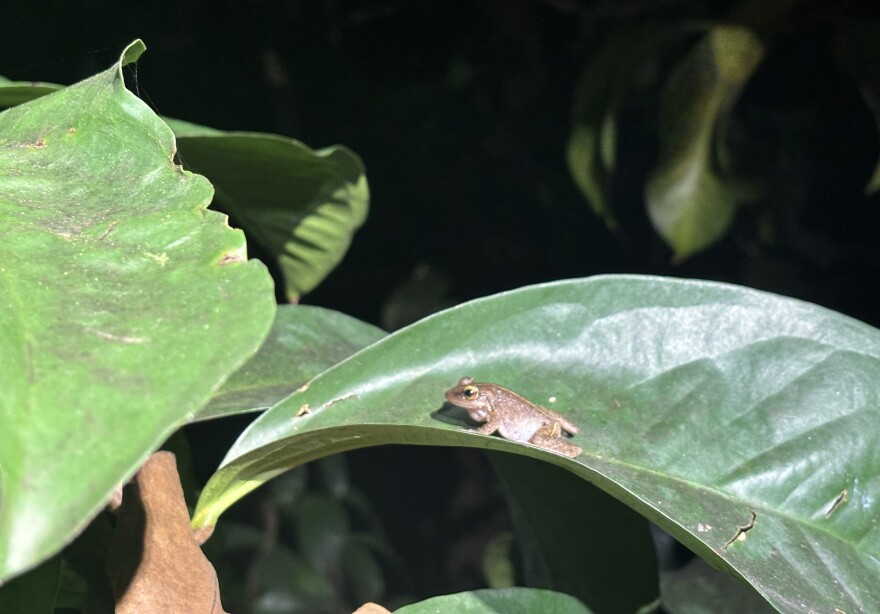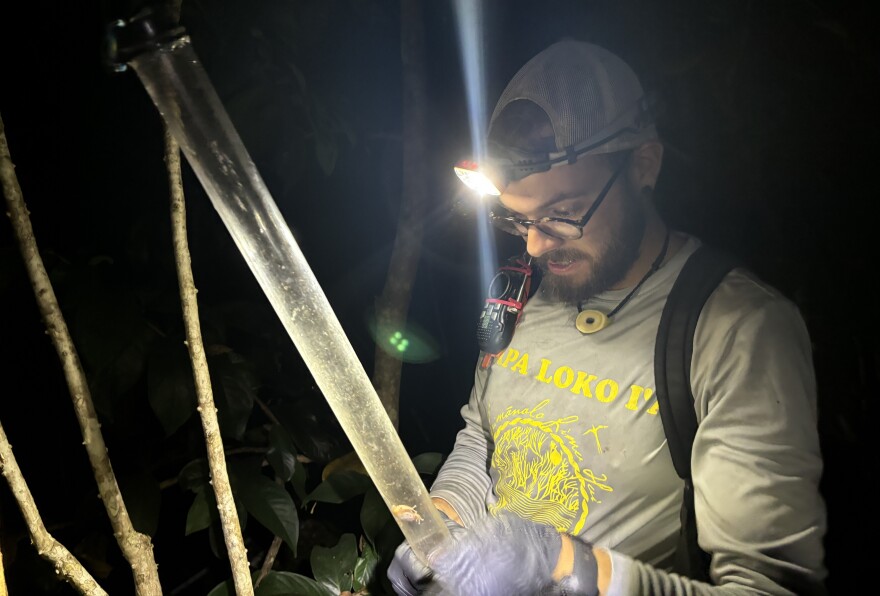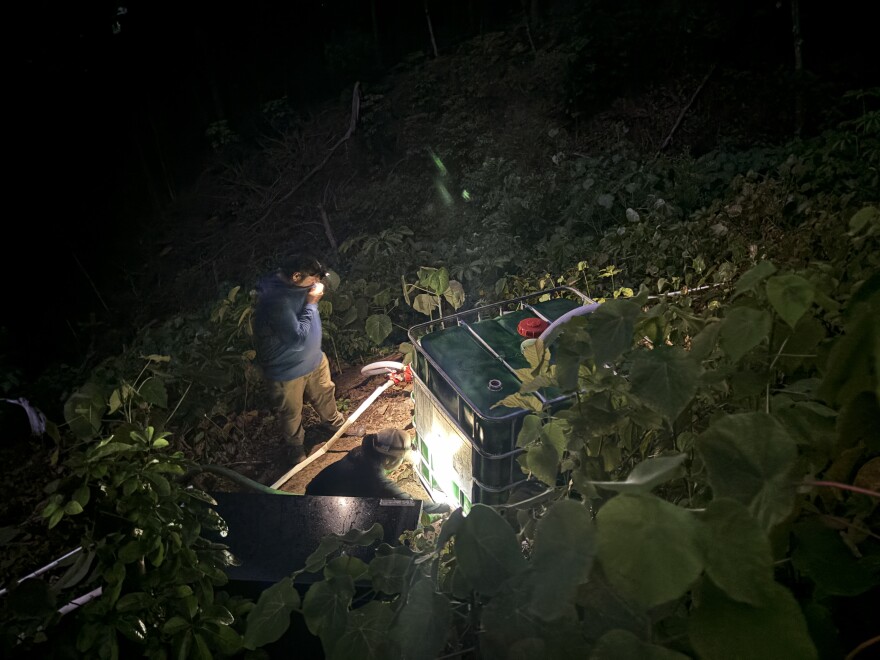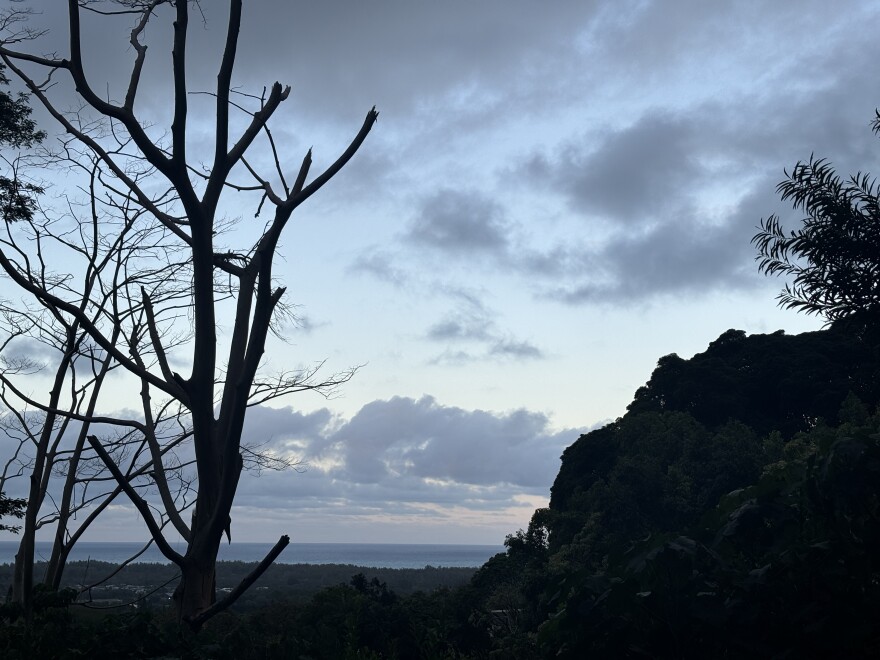The calls of coquí frogs resound through the forest of Waimānalo, echoing off the nearby valley walls.
Amid this chorus, Ryan Chang's ears have honed in on a single frog, croaking somewhere in the broad leaves of a small octopus tree. He turns off his headlamp and whistles to coax the frog out of its hiding spot.
Chang can make a nearly perfect impression of the coquí's distinctive call, a loud koh-kee from which the frog gets its name. But this frog isn't buying it.
"I think he got spooked," Chang says. That one gets away, but there are plenty more frogs in the forest.
Night has just fallen at the base of the Koʻolau Mountain Range in Waimānalo, and the coquí are out in full force. This spot is the epicenter of a coquí infestation that threatens to spread across the whole of Oʻahu.

Chang grew up in Waimānalo and now works as an environmental specialist for the state Division of Forestry and Wildlife.
Every Thursday night for over a year, he's led a team of volunteers into the forests of Waimānalo to beat back the infestation.
Other specialists from state agencies participate as well, but Chang says volunteers provide the main manpower.
"All of us are short-staffed. We just supply the materials and equipment and the training and all that. These people are hammers," he says.
The volunteers rendezvous with state liaisons at Waimānalo District Park shortly before dark. The small caravan of frog hunters then hops in the back of a few pickup trucks, which take them to the edge of the woods behind the Waimānalo neighborhood. The rest of the trip is on foot.
Before entering the forest, the group faces the Koʻolau Mountains, its summit thickly blanketed by clouds. Chang leads an oli, and then they set off into the trees, hiking through the steep terrain, armed with sports-drink bottles and plastic tubes.
When they get eyes on a coquí frog, they place the open end of the plastic tube over the frog, wait for it to jump in the tube, and then quickly cover the opening to ensure the frog doesn't jump back out. Then they shake the frog into their plastic bottle.

Volunteer Zakkaiah Knowles shows off one of the first catches of the night, a brown frog about the size of a quarter with a faint yellow stripe down its back.
"Based off the sound level right now, we're going to be catching quite a bit," he says.
At the end of the night, the team emerges from the forest with 76 frogs in their bottles.
Citric acid to quiet the forest
When he first came out here a year ago, Chang says the calls of the coquí frogs were deafening. He estimates there were more than 1,000 coquís singing in chorus.
Kimeona Kane, chair of the Waimānalo Neighborhood Board, laments how the frogs have changed the soundscape of the area.
He grew up in the valley, and he says it used to be quiet enough in the forest to hear your own heartbeat.

Now, he says the frogs drown out everything, including the sound of the gentle breeze known as li puʻu puʻu, or limu li puʻu puʻu.
"It flows directly from down below us on the shore, and it would bring with it the scent of the seaweed that would gather along the shore," he says. "We can see the leaves moving, but we cannot hear any of its rustle."
Kane often joins the volunteers on their Thursday expeditions into the forest, guiding them through culturally sensitive sites and teaching them about the history of the area.
He taught the group the oli they recite each time before they enter the forest, which he says gives them "the opportunity to connect into layers of Waimānalo’s history."
"And it holds us accountable to how we show up. Even though we have the best intentions, there is still a protocol that must be followed," he says.
Most of the volunteers come from elsewhere on Oʻahu. Kane says he’s heartened to meet people from other communities who have volunteered their time to combat coquí frogs in Waimānalo.
"I am always inspired by folks who make a conscious effort to commit to serving in a community that may not be familiar to them, may not be their own," he says.
Chang says he can hear the difference the volunteers are making, but there are still hundreds of frogs making themselves heard.

To try to rid Waimānalo of coquí once and for all, the group is adapting its methods.
Recently, they hauled 300-gallon tanks of citric solution up the mountainside, which they can now spray across the landscape using firehoses. Chang calls it a "game-changer."
"It took us a whole year to get this infrastructure in place," he says.
Citric acid kills coquí frogs on contact. Unlike caffeine and hydrated lime, which have been used in the past, citric acid denatures rapidly in the environment.
"It’s the only legal way we can treat coquí frogs," Chang says.
Volunteers drench everything in sight. A cloud of citric acid rises in the air.

What’s at stake if Oʻahu does nothing?
Chang says he doesn't like killing frogs. But coquí are voracious eaters, and he worries about them chomping through Hawaiʻi's native insects.
On a recent trip to Hawaiʻi Island, where coquí frogs were introduced in the late 1980s, Chang says he observed a decline in insect species in the forests around Hilo.
"There was not one native insect that we could find," he says. "It should be teeming with life."
In Puerto Rico, there have been reports of coquí frogs eating baby birds.
"Anything that can fit in their mouth, they'll eat," he says.
The coquí are formidable, but Chang thinks it's still possible to turn the tide and return the quiet to Waimānalo.
Soon, he says, the state is looking to partner with the University of Hawaiʻi to send a small team of dedicated staff to this area every night. He also hopes to build out infrastructure across the mountainside to spray citric acid in broader areas.
"It just takes time to build out that system, but it can be done," he says.
Until then, Chang and his volunteer crew will be holding the line.

HPR's Sophia McCullough contributed to this story.
Hawaiʻi Public Radio exists to serve all of Hawai’i, and it’s the people of Hawai’i who keep us independent and strong. Help keep us strong to serve you in the future. Donate today.





